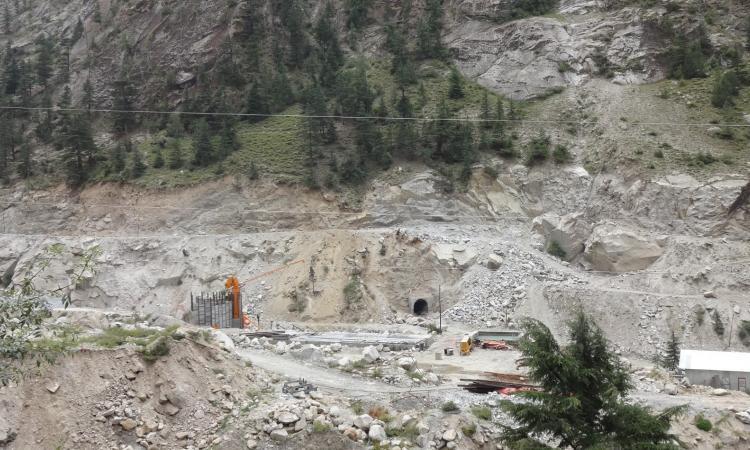
Clear blue skies, natural springs and glacial peaks-tranquility. Falling stones, landslides and debris-chaos! Kinnaur, located on the northeastern side of Himachal Pradesh, lets you experience both. It falls in seismic zones IV and V, which means it runs the the risk of damaging and destructive earthquakes. Also, its young mountains lack deep-rooted vegetation making it prone to frequent landslides.
Since extreme circumstances require extreme measures, the locals, also known as Kinners or demigods, have learnt to live by humouring nature. In lower areas, houses are built by erecting concrete walls interspersed with wooden blocks to absorb shockwaves while those residing in upper reaches use stones held together with clay. The roofs are also made of clay supported by wooden beams. Both these designs not only ensure affinity with the surroundings but also insulate against sub zero temperatures experienced in the winters. Sounds like a good plan, doesn't it?
Then why are residents of Kinnaur having sleepless nights?
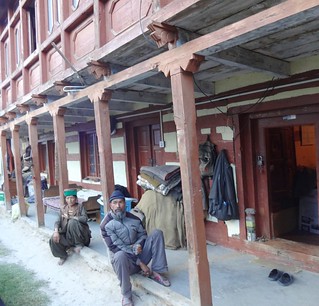
Sunila Devi and her family of seven have a house, a beautiful structure made of concrete and wood to suit the conditions in Kinnaur. However, they are worried that it can come down at anytime. Big cracks have developed in the walls now while the joints in doors and roof have come apart. The wooden planks which were interspersed to withstand the tremors are also not of any help. Around 26 other houses in the region are in the same boat. In fact, it isn't only houses but also terraced farms and apple orchards in the village which have developed big cracks. This has forced villagers to avoid watering them as that will only accelerate the impending disaster of a landslide.
The cause
Inhabitants blame construction activities in the village. While the Border Road Organisation (BRO) is carrying out blasts to expand the National Highway to the Tibetan border, a few meters downhill Himachal Pradesh Power Corporation Ltd (HPPCL) has dug a tunnel for a hydroelectricty (hydel) project on the upper side of the mountain.
View Hydel projects in Kinnaur in a larger map
Tunneling their way through
Pangi village lies near Stage I of the Kashang hydel project, a run of the river (RoR) project, which will generate 66 MW power. Unlike big dams requiring large reservoirs, RoR projects involve a barrage (diversion dam which consists of a number of large gates that can be opened or closed to control the amount of water passing through) from where the river is diverted into a tunnel drilled into the mountains. The power house is usually located at the point where the river is released back to its original path from a height.
Since these projects don't require a large reservoir, the submergence area is comparatively smaller. However, RoR projects require a long network of tunnels to be dug in the mountains not only for carrying water but also for related activities like removing the muck. Such interventions are specifically dangerous to Kinnaur as the hills are still young and in a formative stage. They are prone to landslides and are devoid of deep-rooted trees which can hold the soil together.
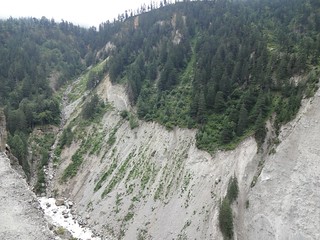
The fragility of these mountains was highlighted in June this year when an unprecedented amount of rain and snow triggered landslides and flashfloods that affected over 70,000 residents. It caused loss of property and damaged apple crop worth hundreds of crores of rupees. The incident did not get much attention in the media because a similar tragedy played out in Uttarakhand around the same time.
HPPCL, which is building the Kashang hydroelectricity project, claims that the construction can't be blamed for cracks in houses and terraced farms in Pangi village. It's officials say that the blasting in the area has been scientifically-designed and that its impact was only upto a small distance. The email reply (see attachment) by HPPCL's General Manager Corporate Planning, also claims that rainwater and snow melt could have sunk the land as the village has geographical indications for the same.
Sadly, Pangi village isn't the only place where such claims and counterclaims fly thick and fast. Similar hydel projects are going on at Tidong Valley and Hangrang Valley as well.
Hydropower and the hills
The power sector has emerged as a big contributor to Himachal Pradesh's economy. The state has the second highest potential for hydro energy in the country estimated to be around 27,433 MW. 30 big and small hydro projects have been planned to produce more than 5,000 MW in just Kinnaur on the Satluj river. Similar projects are being planned in other parts of Himachal Pradesh too. Since most of these projects will be RoR, the river will end up flowing inside tunnels during its 130 km journey through the district leaving only a trickle (15% of the flow) outside.
The related blasting and tunneling are causing substantial damage to the environment. In the case of the 1000 MW Karchham Wangtoo project, the 17 km long tunnel passing under six villages has affected water aquifers causing natural springs to dry up. The claim of the villagers was also verified by the state’s Irrigation and Public Health Department in response to a Right to Information (RTI) application filed by activist Rahul Saxena. The official data showed that 110 water sources had been impacted due to the project.
The muck removed from the tunnels is also dumped along the river banks, which is eventually deposited on the river bed forcing the water to flow at higher levels thus posing danger to nearby areas.
The damage doesn't end with this.
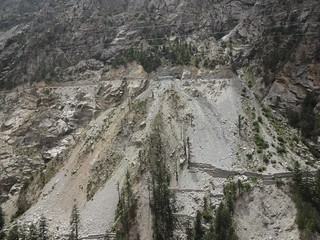
Impact on environment and crops
Kinnauri apples are well-known for their natural sweetness, succulence and prolonged shelf life. Tidong Valley is one of the best apple belts of the region but it is now witnessing a 25-30 % drop in production thanks to the tunneling being done for the Tidong I hydel project. “Because of the continuous construction activity huge amounts of dust settles down on the orchards hampering flowering and growth of apples,” says Narender Negi of Rispa village.
Chilgoza (pine nut) is one of the biggest cash crop of Kinnaur. It fetches more money than apples since the community forests where they grow in abundance, don't require much input and care. Thangi village, which lies in the project area, used to get Rs 8 lakh annually from its common Chilgoza forest. Today, the village gets absolutely no revenue from this because the trees are completely damaged.

While the detailed project report of Tidong I had estimated a loss of around 13, 916 trees in the area, sanction was taken for only 1,261 trees. “More than 5,000 trees were completely destroyed during the construction of approach roads for the tunnel. Of these, over 3,000 were the rare Chilgoza trees. The fact that a Chilgoza tree takes 40 years to flower makes the damage even more long lasting,” says R. C. Negi, a resident of Thangi village.
As is the story of many so-called development projects, compensation wasn't discussed and agreed upon with the affected. The three Gram Panchayats consisting of five villages that are in the scope of the project, were given Rs. 5 crore. A separate cash compensation of Rs. 18,000 per bigha (1 bigha = 0.08 hectare) and a job on the project site were given to 29 families directly affected because of land acquisition for the project. However, all the affected families have approached the court terming the compensation to be inadequate.
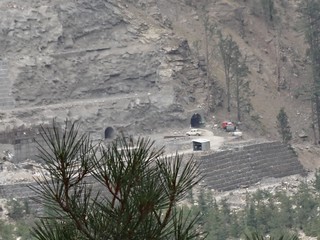
The story at Jangi village
You know you are in Jangi when steep, barren mountains gradually turn green and dense forests of Chilgoza and Deodar trees dawns over the roads. Unfortunately, the scenery may not stay this way for much longer because it has been selected for the ambitious 960 MW Jangi-Thopan-Powari hydel project.
Jangi produces the maximum quantity of Chilgoza in all of Kinnaur with the community forest itself yielding 2 quintals (200 kg) per household every year. A kg of Chilgoza is sold for Rs. 1,000-1,200 thus ensuring Rs. 2-2.5 lakh of annual earning per family. The forest also yields many costly medicinal herbs. Though the project has been delayed due to litigation against the bidding process, locals feel it won't be long before machines start drilling the mountains here.
“Even if the company offers jobs, it won't be able to ensure equal distribution of wealth the way our forest does,” says Priya Negi, a zila parishad member from the village who has been fighting against setting up the project in this area. Earlier, she also opposed the plans of the Indian Army to acquire land for an ammunition depot in the village.
'Don't divert the Kerang'
Lippa village is a big settlement hemmed in by terraced farms and orchards from above and two turbulent streams downhill. It has concerns which are different than the other places. The Kerang stream that runs through it acts as a mitigating force against the Pezzar stream, which brings tonnes of debris to the village regularly. Since Kerang cuts Pezzar diagonally, it pushes away the debris thus saving the village from subsequent damages. The proposed Stage II and III of the Integrated Kashang project will divert Kerang to a 6.5-km long tunnel before it enters Lippa. This will leave the village to face the wrath of the Pezzar alone. HPPCL says it would not use the water from Kerang whenever debris get deposited at the village, but the locals are unwilling to trust its words.
The Paryavaran Sanrakshan Samiti of Lippa challenged the forest clearance given to the project in front of the National Green Tribunal (NGT) on the grounds that it is a violation of the Forest Rights Act 2006. They claim that unregulated diversion of forest land has led to serious ecological losses. In an interim order in November 2012, the NGT directed the project proponent HPPCL to not fell trees and not utilise forest land for non-forestry purposes till further orders.
Stage IV of the project raises even more heckles due to its proximity to the Lippa-Asarang Wildlife Sanctuary, which is home to various endangered species including musk deer, snow leopard, yak, ibex, goral, blue sheep, brown bear, black bear and Himachal's state bird Monal. “The proposed site lies around 4-5 km from the sactuary, which is against the 10-km norm of the Forest Conservation Act. In addition, there are around 80 springs which will be directly affected by the project. The project proponent, however, claimed in its environment impact assessment (EIA) report that there are no natural springs in the area,” says S. S. Negi. HPPCL also claimed that the project site is well outside the wildlife sanctuary.
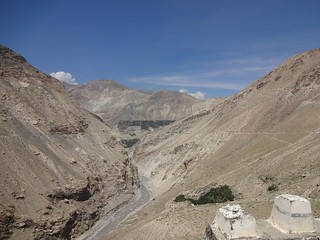 Hangrang Valley also on the radar
Hangrang Valley also on the radar
While Lippa is bracing for more battles, things are also on a boil at Hangrang Valley near the Indo-Tibetan border. A collection of eight villages, this area is the most barren of the Kinnaur district with almost no natural vegetation on its slopes. Nako, the highest village in the valley, is famous among tourists for its lake fringed with willows and populars. There are small, but significant Buddhist temples and a rock is regarded to have the imprints of saint Padmasambhava.
Villagers have, over the decades, turned some patches of land into fertile fields and orchards through consistent irrigation via small canals. These also give way during frequent landslides forcing the farmers to restart from scratch. When lower parts of Kinnaur received heavy rainfall in June, Hangrang valley witnessed untimely snowfall which caused extensive damage to the crops. Hango village, a settlement of 200 families, used to earn Rs. 2 crore every year from the sale of peas. This year, the crop fetched only Rs. 4 lakh.
Planning protests
Tourism, another big draw for the valley, has taken a blow this year but the camp resort of Shanta Kumar Negi at Nako village is still abuzz. The representatives of all the eight villages are meeting here to chalk out a strategy on how to take their protest forward. Tunnels for Sumata-Kathang (130 MW), Chango-Yangthang (180 MW) and Yangthan-Khab (261 MW), will run through this uncertain geography.
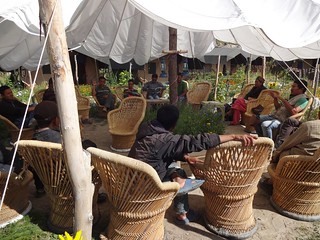 Negi, who has been spearheading the campaign under the banner of Hangrang Sangharsh Samiti, believes the projects will change the face of this valley for worse. “Our ancestors made this area fertile due to their sheer hard work and persistence. We have to live every day humouring nature so that minimal damage is done. Yangthan village is already sliding due to geographical fragility but company officials say blasts done for tunneling won't have any impact. Should we believe them or the knowledge gained over the years through real life experiences,” he asks.
Negi, who has been spearheading the campaign under the banner of Hangrang Sangharsh Samiti, believes the projects will change the face of this valley for worse. “Our ancestors made this area fertile due to their sheer hard work and persistence. We have to live every day humouring nature so that minimal damage is done. Yangthan village is already sliding due to geographical fragility but company officials say blasts done for tunneling won't have any impact. Should we believe them or the knowledge gained over the years through real life experiences,” he asks.
None of the villages has given a no-objection certificate (NOC) for the projects. Last year, around 2,000 people from the valley held a peaceful protest at district headquarters, Reckong Peo, seeking cancellation of the hydro projects.
Though Hangrang Valley still remains the last outpost to be barraged and tunneled, past events show that administration and project proponents can be ruthless against the protesters as was evident in the case of 1000 MW Karcham Wangtoo hydro project in 2006. Policemen fired shots, used batons, teargas shells and water cannons that left several protesters injured. This has left people feeling that the government will do what it wants if it so decides. The same Karcham Wangtoo incident, on the other hand, inspires many others at Lippa and Hangrang to put up a fight. “We are better acquainted with our rights today and more than willing to take legal recourse in case of such transgressions,” Shanta Kumar Negi is quick to point out.
Justification for hydel projects
For some who support hydel projects in Kinnaur, there is an easy justification. The region remains cut off for several months in a year. It's a difficult life without well-maintained roads, year-round electricity and regular income sources other than agriculture and horticulture. Most of the youngsters tread out for the sake of work. Many residents also have children studying in Shimla and Chandigarh and are well acquainted with basic faciltiies like a sewerage system. Dismayed by the state government's efforts, they see the power project as a harbinger of infrastructure.
The hope of a better future for some versus the fear of losing everything for most seem to be the two choices for the people of Kinnaur. Which way will this go?
Watch the video story: